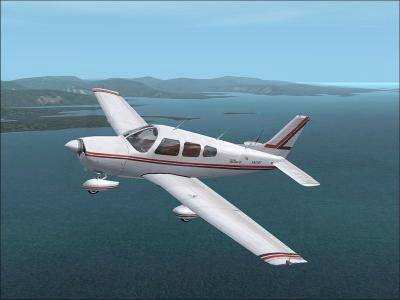Pilot Requested Flight Following Services To COI And Routing “Along The Shoreline.”
Location: Boynton Beach, FL Accident Number: ERA21LA111
Date & Time: January 24, 2021, 20:01 Local Registration: N266ND
Aircraft: Piper PA-28-161 Injuries: 1 Fatal
Flight Conducted Under: Part 91: General aviation - Personal

On January 24, 2021, about 2000 eastern standard time, a Piper PA-28-161, N266ND, was destroyed when it was involved in an accident near Boynton Beach, Florida. The pilot was fatally injured. The personal flight was conducted under the provisions of Title 14 Code of Federal Regulations Part 91.
The pilot was conducting a night visual flight rules flight from Palm Beach County Park Airport (LNA), West Palm Beach, Florida to Merritt Island Airport (COI), Merritt Island, Florida. The flight was operated by a flight school, and the pilot had filed a company flight plan with them.
A preliminary review of voice communication and Automatic Dependent Surveillance-Broadcast (ADSB) data provided by the Federal Aviation Administration (FAA) revealed that the airplane departed from runway 10 at LNA under visual flight rules about 1955 and turned to a southerly ground track before contacting air traffic control (ATC). While in a cruise profile about 1,000 ft, the pilot requested flight following services to COI and routing “along the shoreline.” ATC approved the request, issued the altimeter setting, and instructed the pilot to proceed offshore and “follow the shoreline northbound at or below 500 feet.” At 1958:37, the pilot acknowledged the instructions and repeated the altimeter setting as the airplane began a descending left turn to the east.
The airplane continued an eastbound descent on a ground track about perpendicular to the shoreline when the controller assigned the airplane a new transponder code. When the pilot acknowledged the transponder code instructions, the airplane was at 300 ft and descending. At 1959:25, the airplane’s transponder code changed to one that was a single digit off of what was assigned. At that time, the airplane was crossing the beach at 225 feet and descending. Once over water, the airplane’s track depicted a shallow, descending left turn.
At 2000:00, the controller repeated the transponder instructions, but the airplane’s ADS-B position was no longer being received and there were no further communications with the pilot.

According to FAA records, the pilot held a private pilot certificate with ratings for airplane single engine land and instrument airplane. The pilot’s most recent FAA first class medical certificate was issued October 4, 2019. The pilot was enrolled at 2Fly Airborne in an airline pilot training curriculum and according to school records, he had accrued about 190 total hours of flight experience, 95 hours of which were in the accident airplane make and model. The pilot earned his instrument airplane rating January 20, 2021.
The airplane’s most recent 100-hour inspection was completed January 7, 2021 at 16,366 total aircraft
hours.
At 1953, weather recorded at West Palm Beach International Airport (PBI), 9 miles north of the accident site, included scattered clouds at 2,000 ft and 25,000 ft. The visibility was 10 miles.
The airplane was recovered from the Atlantic Ocean about ½ mile off the coast of Boynton Beach, Florida by a commercial salvage operator on January 26, 2021 and was examined at their facility under the supervision of two FAA inspectors.
The engine cowlings were impact-damaged, the engine mounts were broken, and the engine rested in a “nose-down” attitude in relation to the airframe.
The cockpit and cabin areas appeared intact. The pilot’s seatbelt and shoulder harness were not buckled/attached and appeared intact.
Flight control continuity was confirmed from the cockpit to all flight control surfaces. The right wing was separated by impact and remained attached by the aileron control cable and electrical harness.
Wing-mount fractures revealed failure features consistent with overload.
The main and standby vacuum pumps and the vacuum-operated attitude indicator were disassembled and revealed no pre-impact anomalies. The electric fuel boost pump operated normally with electrical power applied.
The engine’s crankshaft was rotated by hand at the propeller and continuity was confirmed from the powertrain through the valvetrain to the accessory section. Compression was confirmed at each cylinder using the thumb method. The position of each magneto was confirmed before they were removed, drained, dried, and remounted in their as-found positions. Ignition timing was confirmed, and when actuated, both magnetos produced spark at all terminal leads.
The carburetor was damaged by impact, but the engine controls all remained attached. The engine-driven fuel pump was removed and functioned as designed when actuated by hand. Examination of the airframe and engine revealed no pre-impact mechanical anomalies.
 Aero-News: Quote of the Day (12.07.25)
Aero-News: Quote of the Day (12.07.25) ANN's Daily Aero-Linx (12.07.25)
ANN's Daily Aero-Linx (12.07.25) NTSB Final Report: Lafferty Jack Sea Rey
NTSB Final Report: Lafferty Jack Sea Rey Classic Aero-TV: The B29 SuperFortress Doc - History in Flight
Classic Aero-TV: The B29 SuperFortress Doc - History in Flight Airborne 12.08.25: Samaritans Purse Hijack, FAA Med Relief, China Rocket Fail
Airborne 12.08.25: Samaritans Purse Hijack, FAA Med Relief, China Rocket Fail




